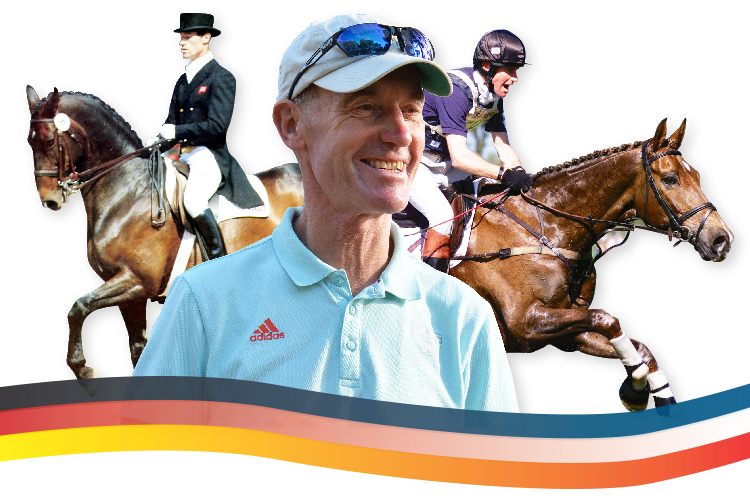
Want to read part one first? http://www.horsemagazine.com/thm/2017/02/christopher-bartle-the-next-step-part-one/
PART 2: The Rider becomes a Coach….
When did you start helping the British eventing team with its dressage?
“I started in 1993. It was after Barcelona, and Lorna Clark was the inspiration you might say for that, because she’d asked me shortly after the World Champs in Gawler, in 1986. I became her personal trainer and then she recommended me to the team and I became their trainer in 1993 and I remained there until 2000. That frustrated me, being dressage trainer, because I was actually interested in coaching the whole thing, and I felt as strongly then as I do now, that there is a connection between the dressage, and the cross country, and the showjumping, and I was always a bit frustrated that once the dressage was over, they pushed me to one side – at the beginning anyway, it became different later on, in the late 90’s.”
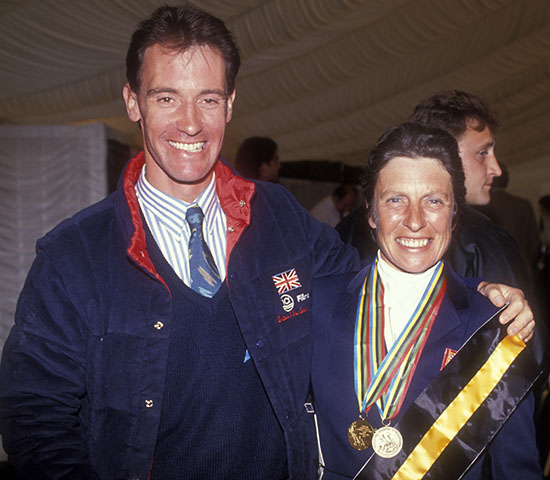
Christopher with Lorna Clarke who started him on the road to being an international eventing coach… Photo Kit Houghton
“That’s what appealed to me about the rôle with the Germans in 2001, because they were looking for someone who would be overall coach, and I was able to put into practice my philosophy, my ideas in relation to the connection between the three phases, and I came across a bunch of riders who were willing to accept that. I was helped at that time by Ingrid (Klimke), who’d been in Sydney 2000 with Sleep Late, who perhaps because of her father’s influence, latched onto the idea very strongly, and because of her status in the team, that encouraged others to do likewise.”
Ingrid and Christopher discuss her test at Aachen
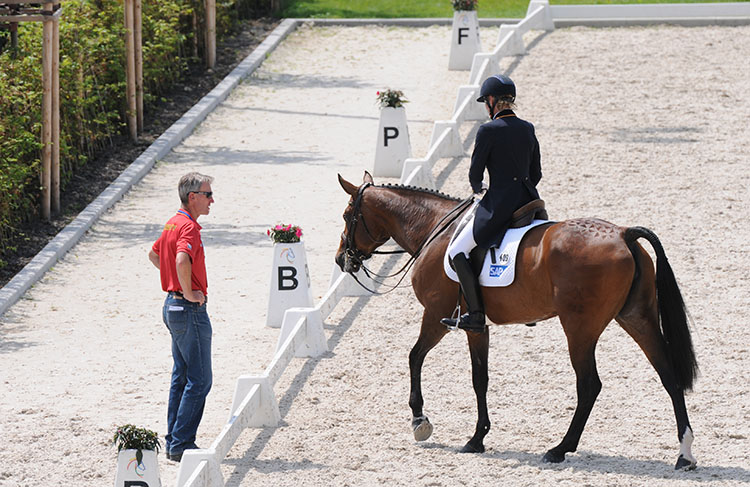
You said the other day that there were some dressage coaches who could work with eventers and some that couldn’t, where is the line drawn as you see it? Ingrid tells me she does a bit of piaffe with Hale Bob to improve his eventing test…
“Piaffe with an event horse is a very relevant exercise. Dressage training in a classical sense was all about training a horse to carry itself, to be able to respond to the rider’s direction, but not to lose its initiative and not to lose its ability to be a true partner to the rider.”
“There have been trainers in the dressage world, and this takes us back to the whole discussion of rolkur, where you are taking away from the horses, their spirit, their ability to look after themselves, you are internalizing them too much. That type of dressage training is contradictory to eventing…
But it is also contradictory to dressage…
“I think you are right – that style of training is more about producing spectacular movement, and it is more about circus than dressage.”
We went through a period in Australia, where riders were told that they had to produce spectacular movement to win a 3DE dressage test – and I kept saying look at Kim Severson and Winsome Adante, look at Ingrid Klimke and Abraxxas – no movement just 110% accurate…
Ingrid and Abraxxas 110% accurate…
“Clearly if you have the good luck to find a horse that has naturally fabulous paces, that also has the brain, and through the training, is classically correct, then you are going to get better results than Braxi. The situation is the same now with Ingrid and Hale Bob, or Michael and Biosthetique Sam – they will be beaten in the dressage by something with better natural movement, but can that horse then go cross country as quick, can he still showjump – if he can, then he is a better horse. But if you go looking for your eventer horse, and say, first I must find a horse that moves like a dressage horse, or, I must find a horse that showjumps like a Grand Prix showjumper, then you are losing sight of what eventing is all about.”
“I have seen horses that are fabulous jumpers, but almost too good jumpers. I saw one in the Spring at Lexington, Allison Springer’s horse, which jumped fence 22 or 23, a straight forward table with a slight drop on landing, it jumped so high that it never touched the fence, but it just rolled over on landing just because it had got up so high behind. You need to have an economy of effort.”
“If the sport goes down the track of more and more CICs, shorter more technical tracks, more emphasis on the showjumping, then the type of horse that is ideal for the sport, may change.”
Is that the way of the future?
“I worry that it is the way of the future. I say worry because I think it would be a shame to lose what is the essence of our sport, which is to be able to train a horse to go the distance, to be economical in its jumping and yet very accurate in its jumping, and to be able to come out on the third day and still be able to jump in a good form and be careful enough. If we go down the route of short format and the cross-countries get shorter and shorter, we are going to get closer to a horse that is a Hickstead or Hamburg Derby type of horse, and that to me would be a shame.”
There is quite a lot of discussion about at what point collection becomes a ‘bad’ thing for the eventer…
“It is an interesting question. The development of the dressage tests over the years has clearly been immense and the demands on the eventer in dressage, so much greater than they used to be. To me, there is a difference between collection, and even quite a high degree of collection, and sustained collection. Sustained collection is holding that period of collection over a long period of time, and within each step or stride, holding it. So in the trot work, passage is sustained collection, more so than piaffe. Piaffe is a natural movement which some horses that are a bit excited before they showjump, or start the race, show. Piaffe is a natural movement that takes little out of the horse, whereas passage with its cadence and the holding of the latent energy for a relatively prolonged period – holding the joints flexed for a long time, that seems to me, contrary to the preparation and actual performance of the gallop and the jump. For that reason I’d see passage as a step too far.”
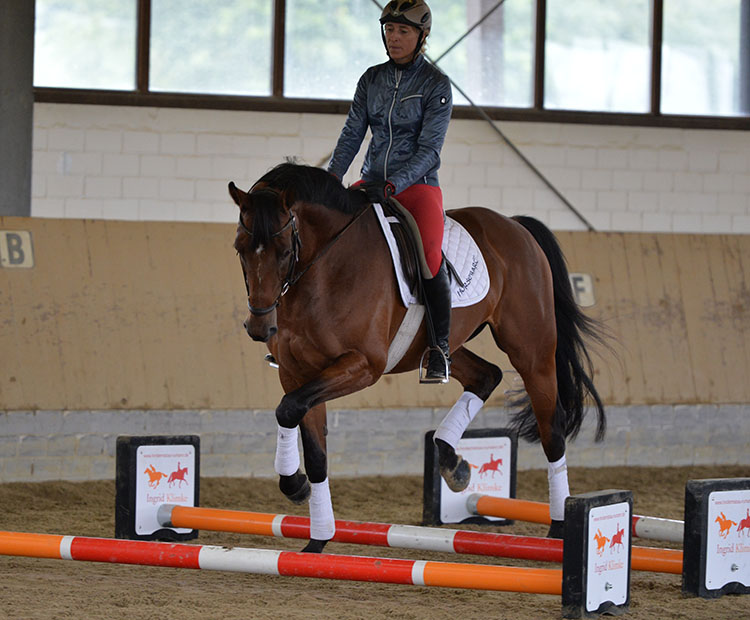
Hale Bob – cavaletti and PIAFFE, improves his trot for the eventing test
“If we look at the canter work, there has been a lot of discussion about whether the test should include canter pirouettes, or half or quarter pirouettes. I would tend to the view that canter pirouettes are a form of sustained collection beyond the requirements of an eventer.”
“Yes, there is an argument for quarter pirouettes, but I would tend to say, that’s a useful training aid but not something we should aim for within the test itself. First of all, the quarter pirouette is very difficult to judge, and I think it would encourage riders to focus too much on that movement, and riding backwards rather than forwards.”
“Counter to that, I have had no success in my efforts, aided by Christoph Hess, to introduce the medium canter with a flying change. I’ve come across a lot of judges who remember when the Grand Prix test had a medium change, and a lot of the dressage horses could not maintain the connection over the back in medium canter and produce a good flying change, so what they did back in the 80’s, was ride a few strides medium canter back to collected, change, then forward again, which wasn’t the logic of the movement. But I’ve always felt that a well-trained event horse should manage the medium flying change, so that’s one movement I would like to include.”
“If we are talking about where eventing dressage should stop, we are probably talking about the Prix St Georges level. Do we need series changes? Again from a training point of view, they are very good, because what they actually work on is straightness. You can’t do series changes correctly unless you have your horse straight. It’s difficult to explain that to the public when you are making the connection between the dressage and the cross country – why do I need changes every four or every three strides, when I am coming to a fence? For that reason, I think it is not necessary, and should not be included in the dressage test, even at a four-star level, but I am less strong on that point than I am on the point of sustained collection…”
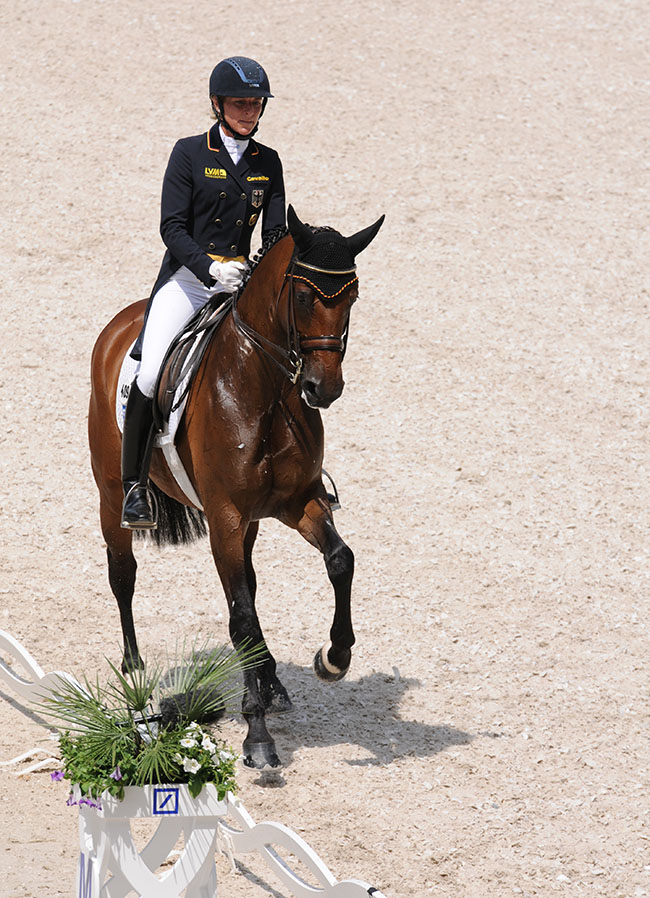
Escada – tempi changes helped the single change…
“There’s Ingrid’s mare, Escada, who got more relaxed in her changes in the eventing test, the more Ingrid rode four times and three times changes with her.”
Is she broken?
“I wouldn’t say ‘broken’ but she is fragile. It was initially Ingrid’s wish to have her in Rio but it was too high a risk factor, while Hale Bob is a much tougher customer – if we are going to talk about economy, there’s an economical horse. He’s a very good showjumper, but he doesn’t balloon his fences, he’s got stamina and easily gets the distance on the cross country. His dressage is not flash, but he is very correct, and he’s got a very good brain. Escada is fantastic, but she is on the edge with the dressage, will she go one way, will she go the other. In the showjumping, she gives them an extra ten, fifteen centimetres and she does the same on the cross country, so she is hard on herself.”
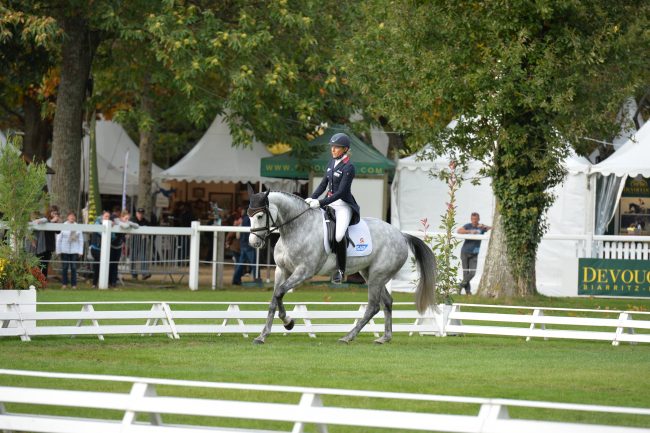
Weisse Duene wins the world title
Ingrid’s new grey mare, Weisse Duene who won the World Young Horse title is a class act?
“It’s a really nice horse, I saw them win on the television, and I had a chat with Ingrid afterwards. She said she wasn’t happy with the bit. It reminded me of the time she rode Hale Bob at the World Championships, and got off him and said, ‘who wants him?’ I suggested she hang onto him and try changing the bit. The difference between Weisse Duene and Hale Bob is that she is quite a rangy mare, she got too long, and I told Ingrid that’s what she needs to learn through the work on the hill – more dressage on the hill and she’ll learn to close up from behind. No dramatic changes to what she is doing, she’s doing it classically all the time, just shorter and more balanced.”
How can Pierre Michelet produce such a beautiful stylish course at Lion d’Angers, when Pau looks a bit unfinished and scruffy, and what’s more about the top fifteen horses in each class at Lion came home without cross country faults, it was a nice confidence building course for the young eventers…
“A course designer is one thing, a course builder is another, Pierre is the course designer, and they have a really good team in Le Lion who are artists in terms of course building. The combination of their course building and his course designing is something fantastic. Pau is always cobbled together. Lion is an incredible event, there is always a huge turnout of people for a one star/two star competition. You are only about twenty miles away from Saumur where you hardly get any spectators. It’s a tradition at Le Lion, the effort that goes into producing those works of art on the cross country course.”
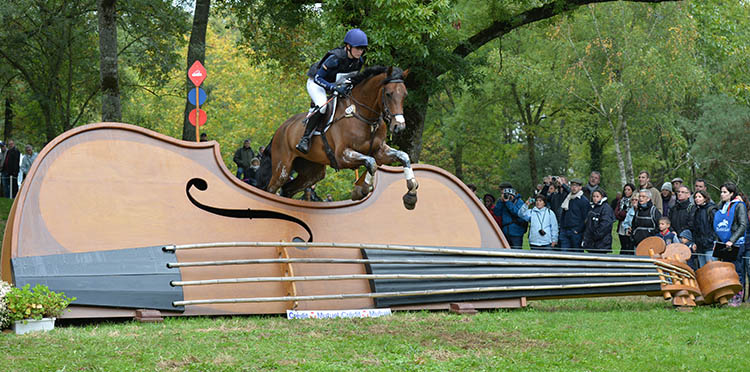
Le Lion – a work of art
Do you think eventing is under threat from the animal rights people?
“The problem we have now particularly in Germany and northern Europe, and you mentioned it when you talked about bad pictures coming out of Rio, is that when you say the word ‘eventing’ the next word people think about is ‘safety’. Eventing is a dangerous sport, what are we doing to make it safer? We are all the time publicizing eventing as a dangerous sport, rather than saying, it is actually the most natural sport for a horse to do. Out in the open, not in a boring dressage arena, doing what a horse does naturally. Sure there are risks, but we’ve really got to focus on the positive side of it. There was a very good article after the tragic death of Ben Winter in Luhmühlen, in the major Frankfurt daily, some sensible journalist wrote a long piece, saying tragic though it was, both horse and rider were having a great time out in a natural environment doing what comes naturally, and that you could feel more sorry for the horse that goes from the stable, wrapped in bandages, into an indoor school with a dressage whip and long spurs…”
Was it a big decision when you decided to concentrate on coaching rather than competing?
“It was back in 2001 and Christoph Hess rang me. It seemed like a normal casual conversation, just a chat until it started to get around to my future plans. It was just after Sydney, and I still had Word Perfect and another four-star horse, but equally, I could see that my long term interest was in coaching, so when I told Christoph that, he went back to his contacts in the German Federation and it all started to happen.”
But was it a personal wrench to say, I’m not going to compete at the Games again….
“Luckily at that point in time, it wasn’t an issue. Sydney had just passed, the Germans asked me initially to do two years, so I agreed to that, and at the same time carried on riding which left my options open. I think for all of us, there comes a time when you have to think long term and having had the stint with the Brits as their dressage coach where I was frustrated not being able to do the whole thing, that was a bigger attraction to me, more than starting with another bunch of young horses, hoping to make it to an Olympics, or a Badminton with another horse.
How Christopher evaluates a cross country round follows
On Cross country rides – you evaluate them as you would a dressage test?
“Absolutely – in terms of the rider’s communication with the horse, in terms of the horse’s response to the rider, the horse’s balance and self-carriage and the lines. Clearly when you come to a dressage test you can talk about flexion and bend, expression, and so on, but so much is on the basics: the balance and the self-carriage, the straightness, the rhythm, the acceptance of the contact – all the scales of training apply as much to the cross country as the do the dressage test.”
How did you physically do that with your German team – you can only be in one place at a time with one set of eyes…
“Cameras all around the course, if possible. Sometimes we would take footage from the organizers, but we would always try to have one or two extra cameras at particular fences to take our own footage, then we use one or two cameras, sometimes more, when we are doing cross country training and we can analyse that immediately, or in the evening, and of course you learn as much from the mistakes of others as you do of your own. You see what the good riders do and you try to copy that.”
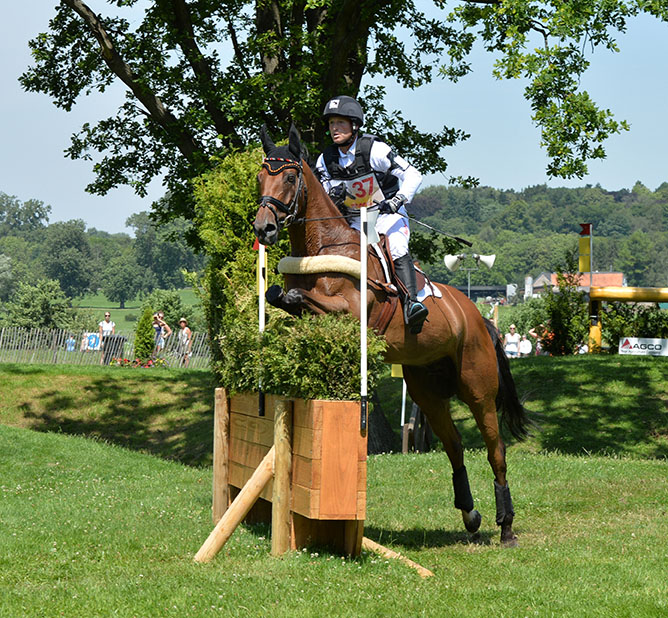
Micheal Jung – raising the bar
“It’s obvious, but it is a fact, as Michi has come along, the riders have looked at him and tried to copy him, and that has raised the standard.”
“We all know there are three ways to train – one is to tell and they do, like you teach kids. Then you have the show and copy system, you show them how to do it or they watch someone else do it and they try to copy. Then the other important way of learning is experimenting, you’ve got to let rider experiment and try and not be afraid of making a mistake.”
“It’s the third element that is critical to a champion, they are not worried about making a mistake. The first quality is will to win, the second is attention to detail, and third, not afraid of making mistakes – the willingness to take a risk. Fourth is mental toughness. I always say in every sport, life goes in waves, up and down, keep rowing the boat and you’ll meet the next wave coming up, but don’t jump out of the boat!”
“I’ve had riders who have ticked all the boxes, yet they haven’t achieved great success because they haven’t had that will to win…”
It was time to pull on our walking boots and join Christopher as he looked at a few of the Adelaide four-star fences, and more importantly, explain how they should be ridden…
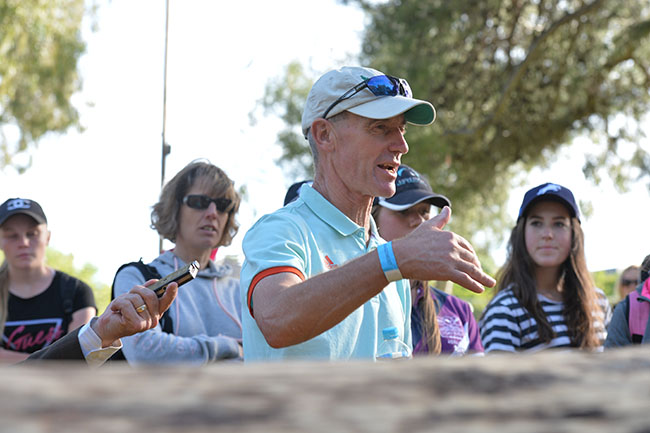
“Okay, Fence 1 is quite a simple fence, but we want to see our preparation point well down the course, and bear in mind every stride is half a second. With that in mind, we’ve come out of the start box, we have a nice rhythm to this fence.”

“Some riders ride backwards to the first fence – if you ride backwards to the first fence, you are going to be riding backwards all the way.”
(A big thank you to Peter Jones who helped out with fence photos…)

“Here we are at fence two, we won’t dwell on it, but it is an opportunity to set out my rules – the rules are rhythm, balance, and in terms of riding the line, I have a rule that you make the turn before the fence, so always use the turn as a preparation point – preparation point for tempo, in other words, speed, balance, degree of collection you need. This is a rhythm fence, in other words, you can keep coming in quite a high tempo, but keeping the horse balanced, and look over the fence, not down into the bottom. Two pairs of eyes, the rider’s got a pair of eyes, the horse has got a pair of eyes, each do their own job, and be aware of the distance the horse is seeing.”
“Quick away from the fence and you get into your racing tempo again, you’ve got to find a rhythm that is comfortable for your horse, and bear in mind, you’ve got a long way to go.”

“Here we are at the third fence, we are still in that first phase of the course, where the course designer is looking for us to get into gear and settle into a rhythm before the technical questions come. I’d have a bit of respect for this, even though there is a straw bale underneath and a shrub in front of it – you don’t want to be making contact with the front. It’s not hugely wide, so you are coming in, as I said before, make the turn before the fence. I have a rule that you want to meet each fence on the inside of the midline, so I am coming off a left hand turn, I would tend to jump it slightly left of centre, this helps because it gives you a bit of a ground line here, look ahead to where you are going to go next, towards that tree, and then you don’t get too hooky to the base.”
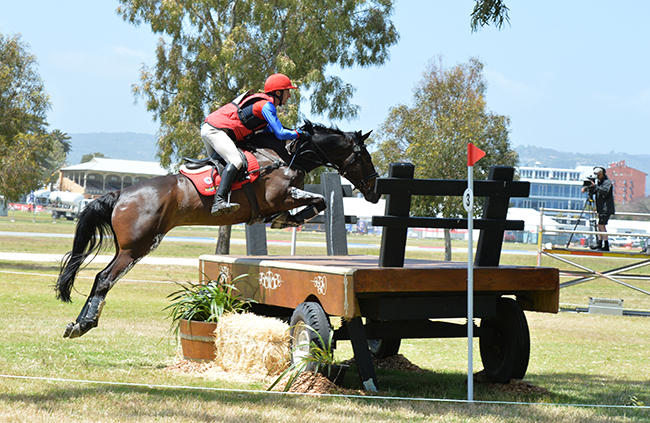
Rohan Luxmore shows how to do it on Bells & Whistles
“Hands down, eye up, and stay a little bit away with your upper body, to let the horse use its shoulder.”

“What we have here is an A / B situation, very slight curving line from 4a to 4b. What’s interesting when you see this fence from the side, is that there is a slight drop on landing, a fairly wide box. What’s so important in all these combination questions, is the security of your landing position, because that becomes the first stride in the approach to the next question. Turn before the fence, come up there at relatively high speed, you know you’ve got to land and curve, so you don’t want to be flying over this, then not be able to balance them in the turn. So you take a little bit of tempo out in the turn, not going out too wide, because that is a waste of time, but controlling them on the outside rein while you look for the line over A. Once you’ve nailed the line to A, then even before taking off at A, you will be looking to B, and what’s important there, is that as you land over A, weight in your stirrups, eye up on B, and not have that ‘nod’ on landing which one sometimes sees in cross country riding, where for that moment, the rider has lost their line.

Fence 4 A from the side, very different from front-on
“The point that I make to riders time and time again, is that the horses have never walked the course, so they have to assess things in a mille-second, whizzing past tree left, and tree right, then suddenly you have tree stumps you have to jump and not whiz past.”
“On the positive side, because horses are such intelligent, quick thinking characters, they help us out an awful lot if we give them a chance to do that. If you can guide them correctly, and not dictate to them, that is the essence of fantastic cross country riding. You’ve walked the course yourself, you know what is coming, therefore you have them in the right tempo and the right balance and the right gear for the question, then show them the question and allow them to do their job.”
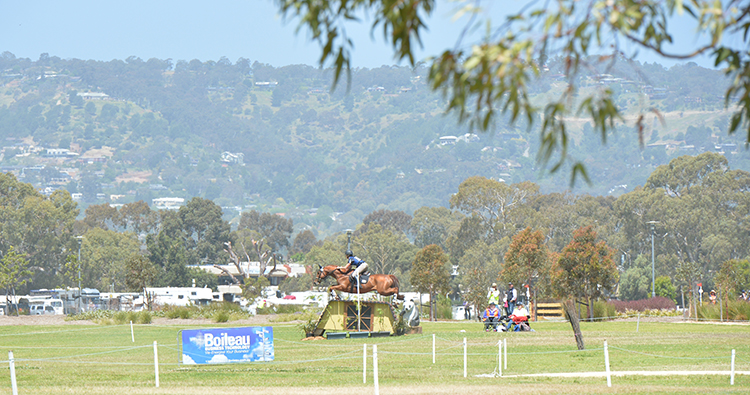
Hazel Shannon and Clifford are on the job…
“Once you guide him and have his focus on the next fence, he should do his very best job, but it is up to us to have the line right, the balance right, and let the horse focus on his job. It means letting the rein a fraction longer before the take off, because if you jump this like a showjumper with your hands half way up the neck, leaning forward, then you could lose your first stride on landing.”
“We could all measure this, I did yesterday, and it is probably three strides, but I tend not to talk about strides, because every horse is different, you can have a giant and you can have a pony. What’s most important is that you focus on the balance and the line, allow your horse to use his eye, and use your eye to see what distance the horse has seen.”
next fence 5

“We are coming in off quite a long gallop to what they call a stick pile, quite big sticks! The line is very slightly bending, and it can be ridden at a relatively high tempo, which you will have coming off a quite open gallop. The important thing with a big wide fence like this, is not to take the first stride you see and take off too soon. Keep the rhythm, soften the hands, come a little bit deeper to it, let horse come a little deeper by being softer with the hand.”
“The most important thing about the stick pile, is that the next question, 6 A / B is two angled brushes, so in jumping this, we’ve got to the going out to the turning point to achieve that line from A to B.”

“You’ve got the red flag of B, the white flag of A, that creates a tunnel with the tree in the background. That’s my line of approach.”
“Come over the stick pile, straight towards A, we would then have to pull right and then left – and that’s confusing to the horse. It’s always helpful to line something up, like a tree in the distance, a point behind the fence that is your target as you come through the turn, then you know you’ve got your line to the angled brushes.”
“So we’ve come over the stick pile at relatively high tempo, but then we have to get that preparation point in the turn, without losing too much impulsion and tempo, because we want a positive approach to 6 A / B, at the same time we have to make sure the horse is seeing the line. When you have these angled fences, my rule is always to keep the degree of angle, as little as possible. I could take a one metre step to the left and make it tighter and that could be even better, I’ve still got that big tree in the distance as my line, but by doing that you make the question clearer for the horse, you are not angling each fence quite as much.”
“As soon as you have these angled fences, some people will walk the distance and calculate how much it is. I always want the distance to be on the short side, so that when I jump into the second stride, my body is coming up, rather than hunting for a second one. So keep the distance on the short side. If you are looking from here, you’ve got the red flag of B, the white flat of A, that creates a tunnel with the tree in the background. That’s my line of approach. They’ve got a nice shape to them, a nice round shape in front, so I am not too worried about the front profile, I’m always going to look at B, not at A, and if I keep my eye focused on B, then I should hold my line.”
more of the course follows
“The critical fence at Rio, the angled brushes, where I would say a lot of the problems happened because the riders were not looking at B, they were looking at A. Don’t look at A, look at B.”

7 A, you can see 7 B at the top of the hill, it was more of a slope than it appears in the picture, 7 C is on the other side of the slope, and the horses couldn’t see C until they were jumping B – have a look at the drone clip of the course to get a real feel of this one – link at the end of this piece…
“The first fence is quite a wide table, coming off the turn, we are going to be able to keep quite a high tempo to it, but bearing in mind, we’ve got to turn up the hill to the fence between the pickups, and down to the corner.”
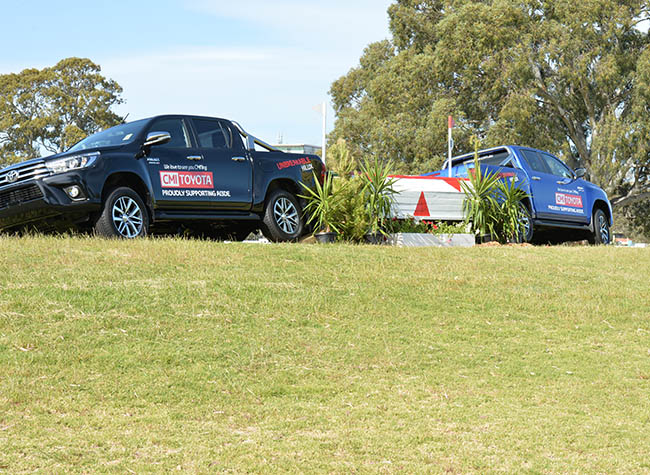
“I would be wanting to come on a turn such that I am giving my horse the idea we are going to turn left, so that we can have as smooth a turn as possible up to the top – not having to pull the inside rein to get them up the hill. Ride it like a dressage test, it’s a large arena, but ride it a bit like a half circle, 20 or so metres. And always, as in dressage, control with the outside rein and inside leg, inside hand guiding.”
“As you come up the hill, stay a little bit up in your position. We want to make sure we have given enough rein that the horse can bascule to that fence between the pickups, without pulling our upper body forward, so that the whole time, the rider can keep the eye on to the corner Fence C at the bottom of the hill. It’s all about landing in balance, eyes left, riding the curve to the corner and once again, looking through the flags to the corner to something behind it, rather than looking down to the corner and interfering with the stride. The horse can understand the line, and if you have balance and impulsion, then the horse has options.”
“We could measure the distance and for a lot of riders that would be helpful to know, but you mustn’t get fixated on the number of strides, because sometimes that will be out the window, depending on what the horse does over the fence at the top. He jumps big, or small, or hangs a leg, or makes a mistake, what is more important is balance and making the line clear to the horse.”
Looking from 7B down the hill to 7C
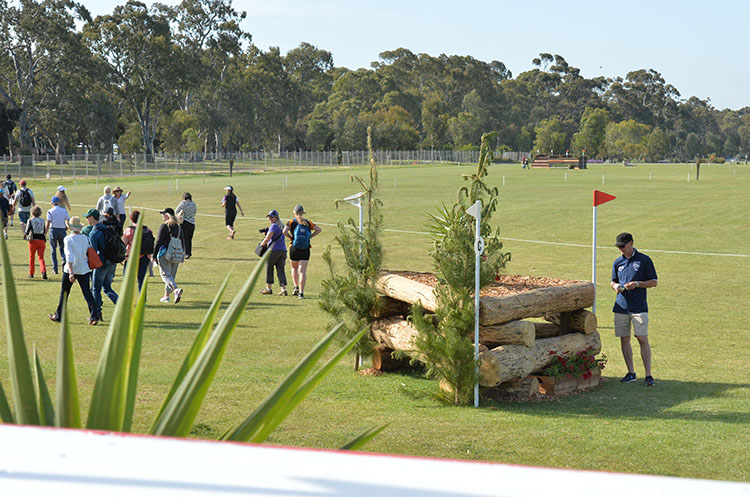
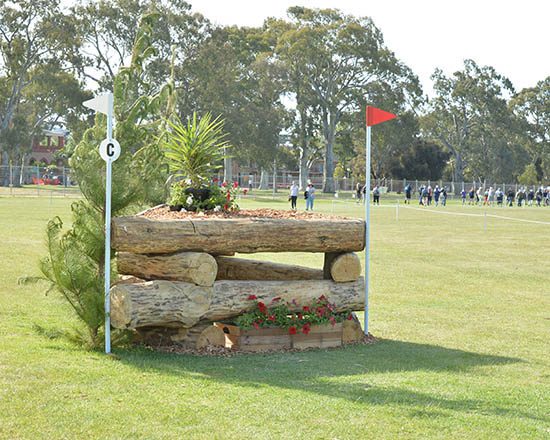
“So we walk the curving line past the pickups at the top of the hill, bearing in mind that coming up the horse doesn’t have sight of the corner until he comes over the fence between the pickups. We mustn’t come up cutting the corner, and end up jumping this fence drifting out to the right. We’ve got to be out far enough that you come to the fence with the idea of meeting it absolutely square, slightly on the inside of the mid-line, then as we jump this with enough freedom of the neck that the horse can complete his jump without pulling us forward, but not with the reins so long that you lose control in the turning at the top of the hill, and come down in line to the corner.”
“It always helps to keep the hands low. I always recommend a single bridge rein, join the two hands together to control the shoulder, and don’t pull on the inside rein through the turn, then the horse can stay balanced. Stay a little upright, and focus on a point behind the corner that is your target, in the same way that in a dressage test as you enter, you focus on the judge’s box at C and stare at the judge’s eyes at the end of the line.”
no, Michael Jung wasn’t at Adelaide, he’s using a single rein bridge, as recommended by Christopher
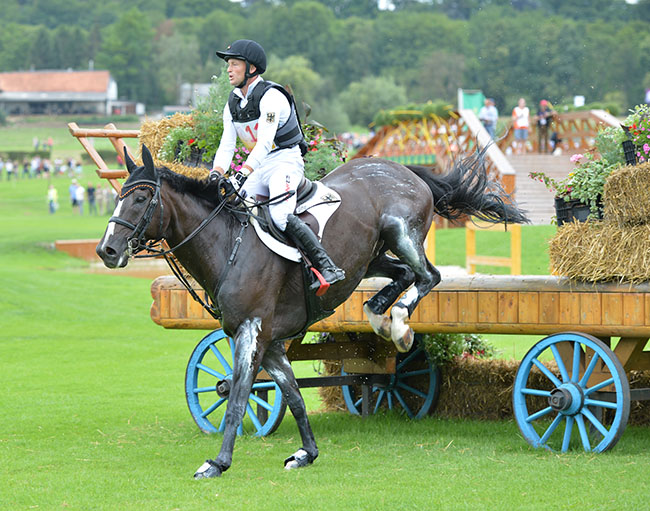
Michael Jung riding Halunke – note the single bridged rein…
“Land, balance, turn, I’ll just stride that out and give you my estimate – probably four strides. So have an idea in your mind, but don’t count that it has to be four, it is what it is, and you focus on the line. Now as I look through the flags, I see a house in amongst the trees – look at something up there, don’t look at the base of it, then you will stay away with your position.”
“It’s vertical enough in front. Always ride a cross country course with the what if? in your mind. What if my horse leaves a leg? What if my horse sees something at the last second? You want to be in contact with the saddle, not heavy contact, but in contact where your legs and seat help keep the horse straight, and you channel the horse, your eye is focused on the line and try not to get in their way by fighting with their mouth.”

Fence 8 – “a proper four-star rhythm fence”
“We won’t dwell here, except to say this is my idea of a proper four-star rhythm fence – just keep coming in a rhythm, it’s got a nice ground line in front of it, it’s a good one for the photographers, but shouldn’t cause too many problems.
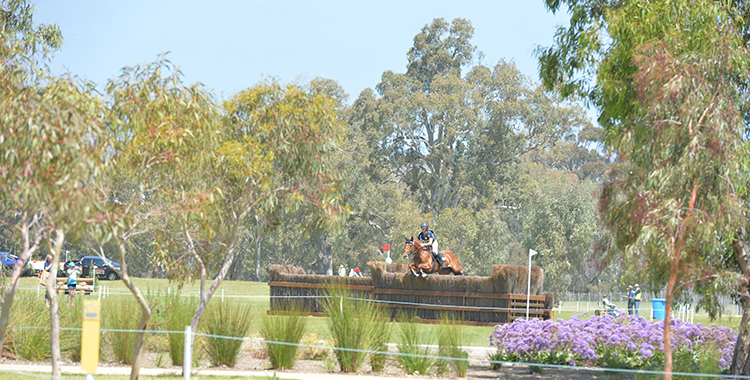
Hazel and Clifford were on their way to victory…
Just make sure you get the curve before the fence, that you jump it straight and don’t jump it on the angle because that makes it significantly wider.”
more below
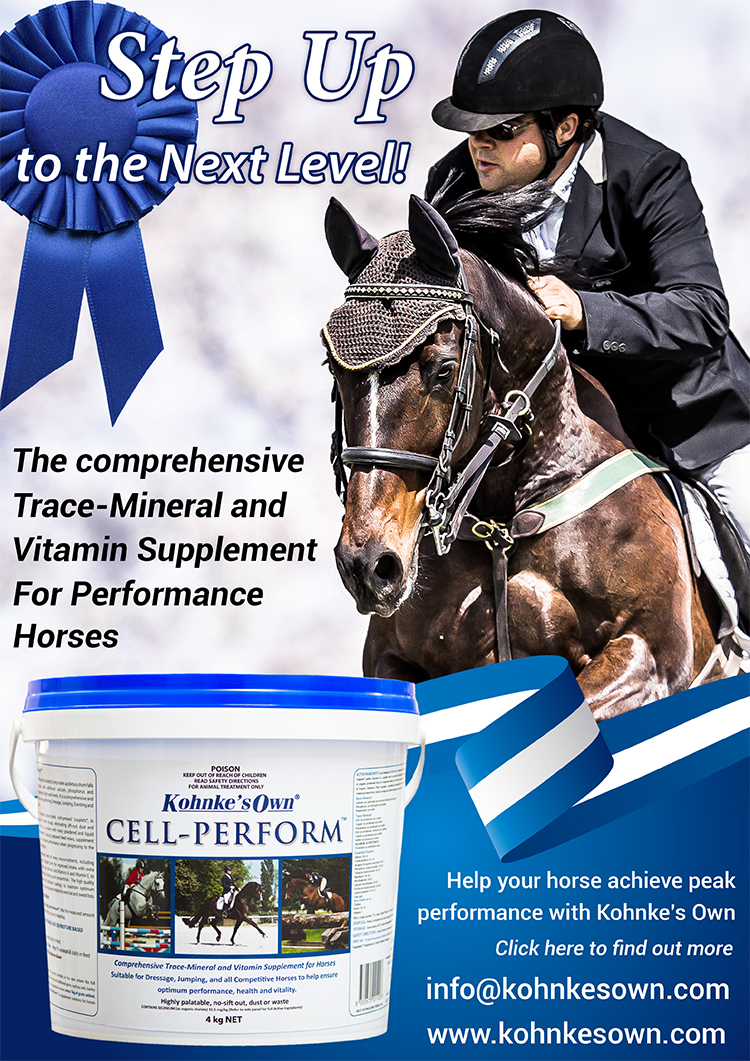

“Now this is what Mike ES (course designer, Michael Etherington-Smith) described as just a way of getting over a ditch. But often when I ask my riders as we walk the course, which is the toughest fence? Oh the ditch, or the water… NO, it’s the next fence.”
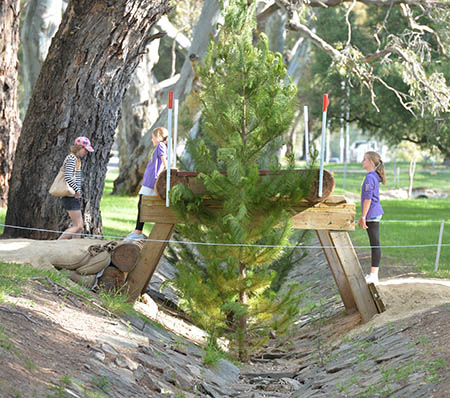
“At every fence you’ve got to be aware of what might happen, there’s a drop on landing, not very high in front, so be good in your landing position.”
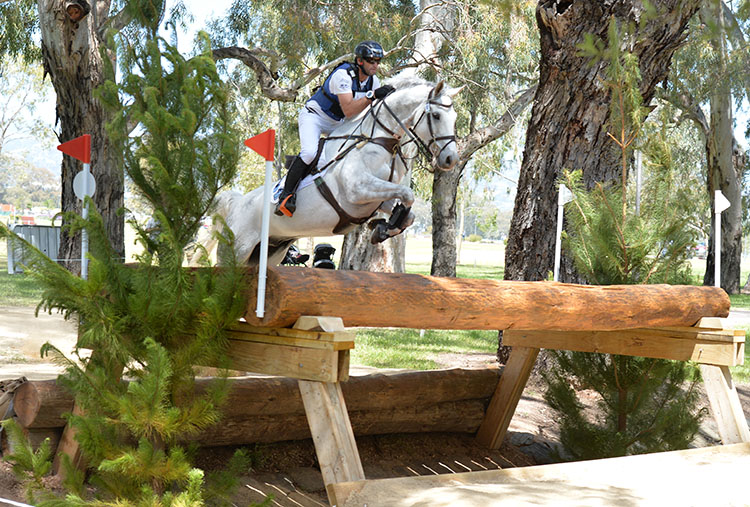
Stuart Tinney and Warhawk – no problems
“We know what is coming next, we know what pace we can approach a fence at, what the line is afterwards, therefore we have to have what we need in the dressage arena: extended canter, collected canter, without fighting the mouth, balancing the horse, the horse going to the contact, the contact being an even contact, where we can guide the horse and not be fighting with him. That’s all dressage, and we need to bring that to the cross country. What we want is the poll up and the nose forward, the horse uses his eyes with his nose forward. Where you can get wrong dressage, is when you roll them over, and get them looking at the floor all the time, do that, and then in the preparation point it is not clear to the horse where he is supposed to go and he sees the fence too late. So we must get the nose up and forward.”
next Christopher discusses martingales…
“I get obsessed with martingales, I’ve taken martingales off almost as many times as I’ve had a cooked breakfast, because I think the martingale either comes against them at the critical moment, or they are obedient to the martingale and they drop their head.”

“Here we are coming over the road and up to a fence which is fairly innocuous, but again, I would want to meet it fairly straight. Keeping a little bit to the right of centre gives you a little more ground line to the fence, which will help ensure you don’t get too close to it. The ground is undulating, keep the balance, keep the rhythm, don’t ride backwards, and use this little bit of a ground line to come over the fence.”
“Eyes up where are we going next? That’s one of the challenges of Adelaide, you’ve got to know the course well enough to know, inside that tree, outside that tree.”
“You’ve got to look way down the motorway, not just looking down in front of you, and then you get no surprises, and the horse gets no surprises.”

“Just be careful you don’t get here with too much pace, and end up flying over it. You want to come over the road, sit up a little bit, let them jump it a bit more economically, so that you can then take the inside line on the turn. Mike always puts his fences where he tests your landing position.”

“When we are coming down here, aware of the fact that we’ve got that turn to the next fence to come. Balance, sit them up a little bit, hands down, bounce them a bit on the hind end, this is where the dressage on the hill at home helps, the horses get used to balancing themselves coming downhill – and the riders as well. As we come over this fence, immediately looking to pick up the line through 13 and 14 a / b.”
“Here we have lovely conditions with the going, but you always have to think what might happen. What studs do you put in? If you put in too much stud, it grips the ground too much and that’s not so good for their joints. You can sometimes have too much stud in front and the horses slip the shoe off, so I tend to put not much in front, especially with ground conditions like they are here. I use a little more stud behind, so when you are coming downhill, the horse can balance himself on his hind leg, but there is still a little movement for the front foot, which takes the jar out of the ground.”
“Be aware of the camber of the turn, always thinking, motor bike turn, that means weight to the inside stirrup, control on the outside rein. Then you can negotiate the turns effectively. In London in 2012, where it was very steep up and down, and very tight turns, we had to put another stud hole on the hind shoes, on the outside edge – so we went round with three studs behind, so we could really go quickly through the turns, and manage the steep downhill approaches. It’s a bit like Formula 1 where you have to put the right tyres on for the conditions.”

“We are aware of the ditch on the other side (14A), and then there’s the skinny, so what is absolutely crucial here, is that in the preparation, we have closed the canter enough. In dressage we talk about extended canter, medium canter, collected canter. Coming downhill here, we want a somewhat collected canter, horse on the hind legs, hands down , so that when we get to the bottom we can sit in the saddle and ride positively forward.”
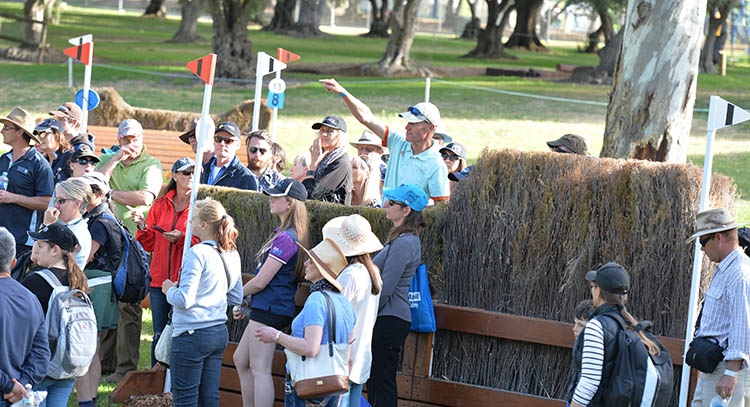
“If we don’t get the preparation point here, then the risk is that the horse might be proppy and make a mistake – see the ditch at the last moment when he is going over the fence… Get the canter on the hind legs so that when we get down to the bottom, I’ve got contact with the saddle, a nice long neck, and I can be yes we can. Eyes always up through the skinny at the back, that’s what is important. Don’t let my eye be dragged down to look at the ditch – the horse does the ditch, I focus on the line. Two pairs of eyes work efficiently together. Always look up through the flags when we come to the skinny. Look high through the flags, don’t look at the base of the skinny. Very often the mistake riders make is that they focus on the ditch and then look up for the skinny, or they are looking for a distance, rather than looking up through the flags.”
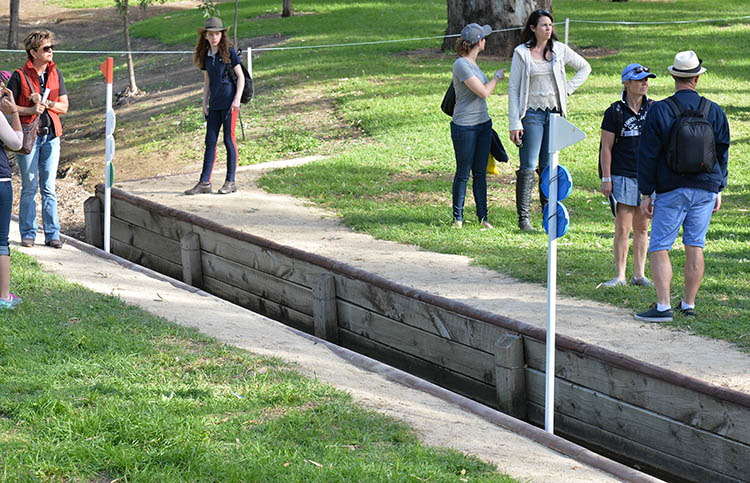
“So we have 13 (the brush) and 14 a (the ditch) and 14 b (the skinny). The risk here is that the horse sees the ditch when he is half way over, and if it hangs a leg, you could be pitched in front of the saddle. So you jump this with that in mind, keep two thirds of your horse in front of you at all times. It’s like being in the middle of the plane, get behind the centre of gravity, keep the nose of the plane up in the air – the more length of neck you have here, the better.”
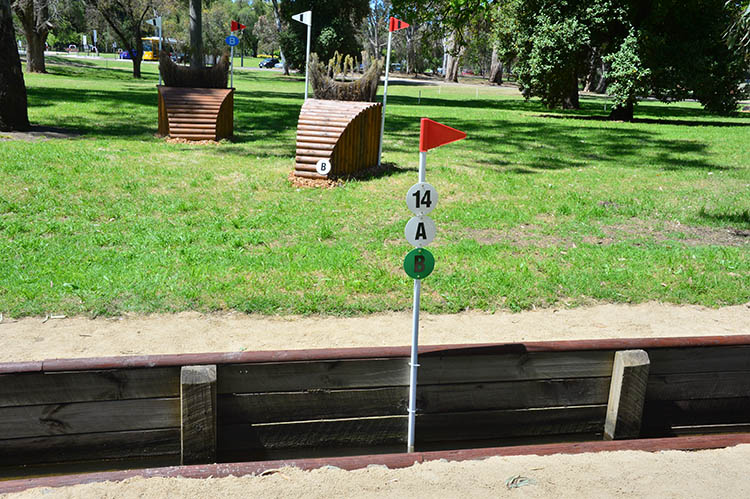
After the skinny, we come around to the left to Fence 15
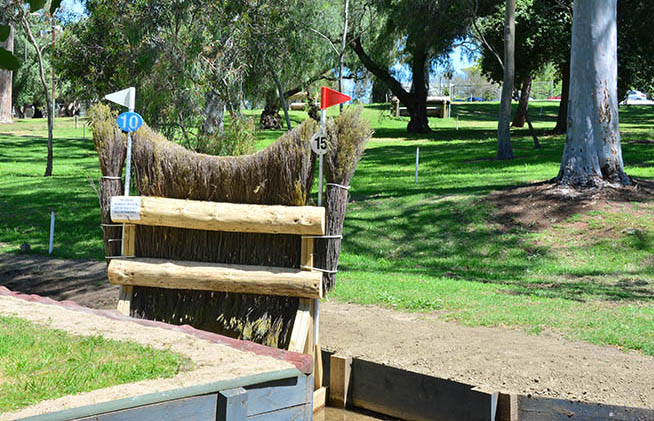
“Depending on your horse and how you’ve negotiated the fence before, if you want to play a little bit safe here, you come a bit further round, you get a bit more square to the panel, and jump to the tree with the bigger tree trunk – you’ve got a bit more ditch in front, that gives you a better ground line. But if you want to save a second or two, you can come on a slightly tighter line, and jump towards the skinnier of the two trees. If you were having a good run up to here, you would probably go for that. Always bear in mind that the horse might see his way through to the right of the fence. Very important if you are going to ride this tighter line, that you look through the flags to a point beyond it, and not get sucked in with your eyes to looking down into the ditch.”
“Even with simple fences you have to think about the surroundings, here the horses suddenly come across the road and into an auditorium filled with people and that might make Fence 16 more difficult.”

“Then we have a slightly downhill approach and there will be a lot to look at, crowds around the lake. As we come round the turn from the flower box, then we want to get the horses balanced on their hind legs. We should be good and secure for the landing with enough length of rein that we don’t lose our position on the landing, then straight away on landing, I want to close the horse again, so I can sit in the saddle and ride positively to the water. The risk would be if I flew over the flower box, and just kept flying on down towards the water – we’ve got to get a preparation point in, before we ride positively to the water.”
“Land, close – it’s not about riding backwards, it’s about balancing, closing them from behind, use your leg, don’t just pull on the mouth – leg and seat, come close to the saddle.”
“So you don’t sit heavily or strongly in the saddle, just close to the saddle, come into the dressage seat, sit very definitely into the saddle, slightly longer rein, widen the hands a little bit to keep the horse channeled and focused through the flags, with enough length of neck.”
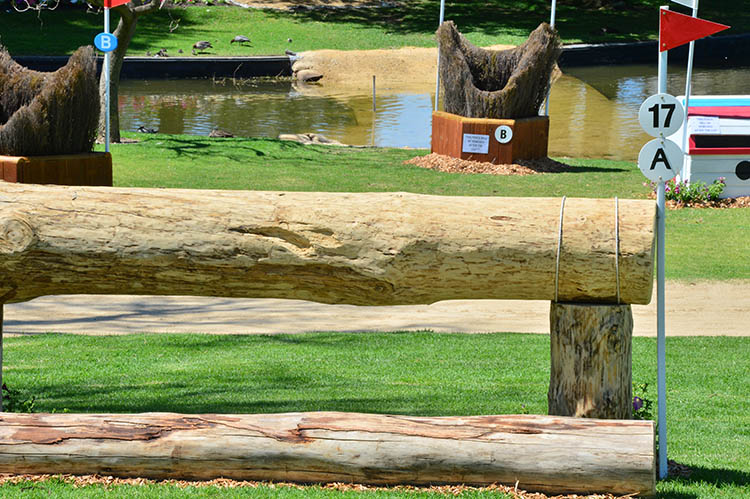
“It’s nicely built in front, so it helps me from a confidence point of view, that even if they run a bit deep, they can extract their front legs.”
“But there is always the what if, the horse can leave a leg so I want to behind the centre of gravity. Two thirds of the horse stays in front of me at all times, and the best way to do that is look up high, and not get sucked into looking down.”
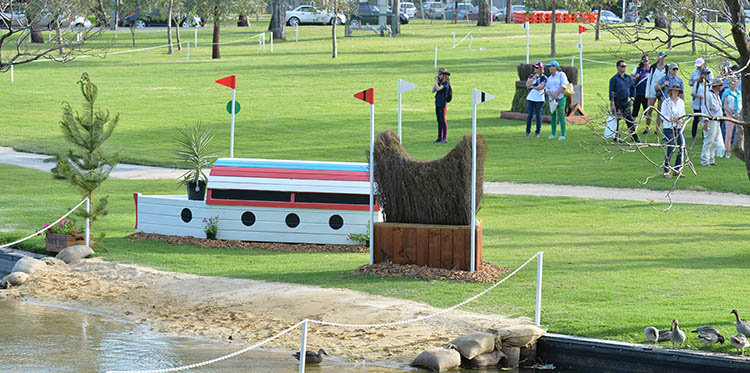
“Now into the water, over the island, back into the water, and out the other side. It is a slightly uneven line. Here the water is quite shallow, but the depth of the water can play a rôle in how the horses react. With deeper water they can sometimes be ‘stopped’ by the water, and stumble in the next stride on landing. Always be good in your position in the second stride, don’t say, oh I’ve cleared that, now off we go, stay up in the saddle…”
At this point gentle reader, Christopher started to turn to the north, away from our hotel and a refreshing white wine, and at this point we decided that this amazing cross country lesson was large enough and insightful enough. I hope you agree.
And thank you once again Christopher for your generosity, these two articles arose from interviews at Pau and Adelaide, long interviews, but I think they result in a quite extraordinary insight into the thinking of this brilliant trainer.
***NOW ENJOY THE DRONE FOOTAGE OF THE COURSE – link below
DRONE FOOTAGE of the course, here: https://youtu.be/UjqSDKEjvec
If you are interested in Eventing, there’s a whole library of articles just a click away:
http://www.horsemagazine.com/thm/article/eventing/
Breeding an eventer? How about Kanndarco? With the Kannan rideability? Check out the range of top European stallions available in Australia from IHB – www.ihb.com.au
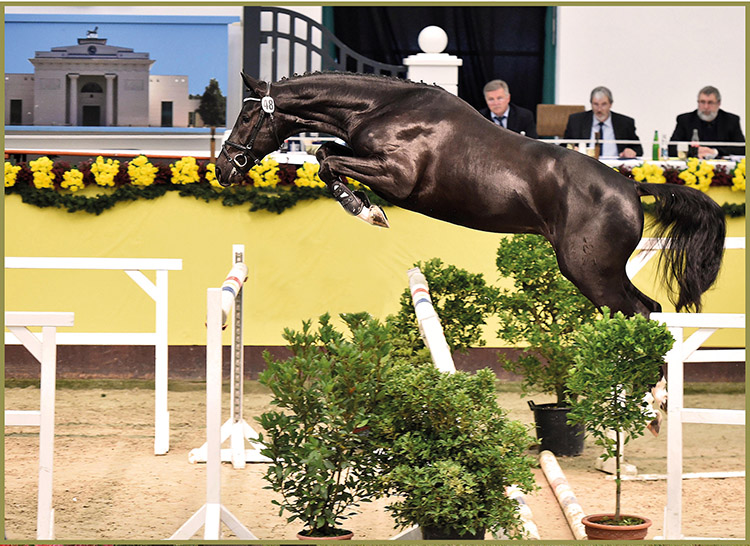




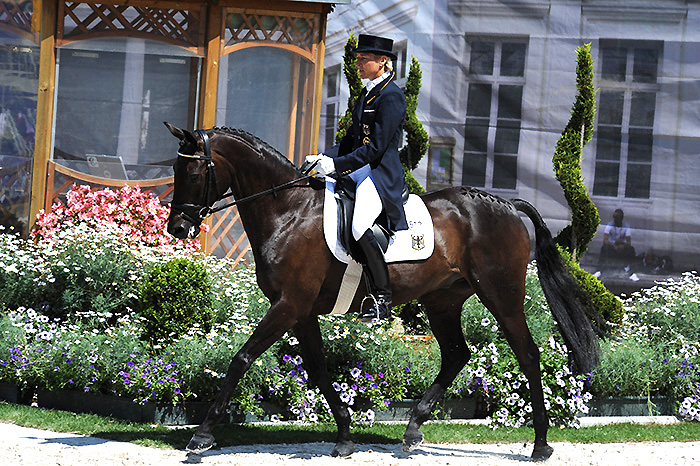
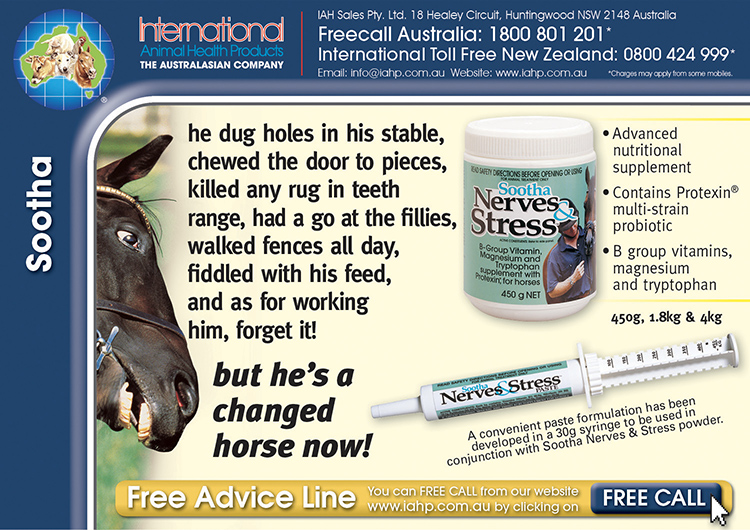
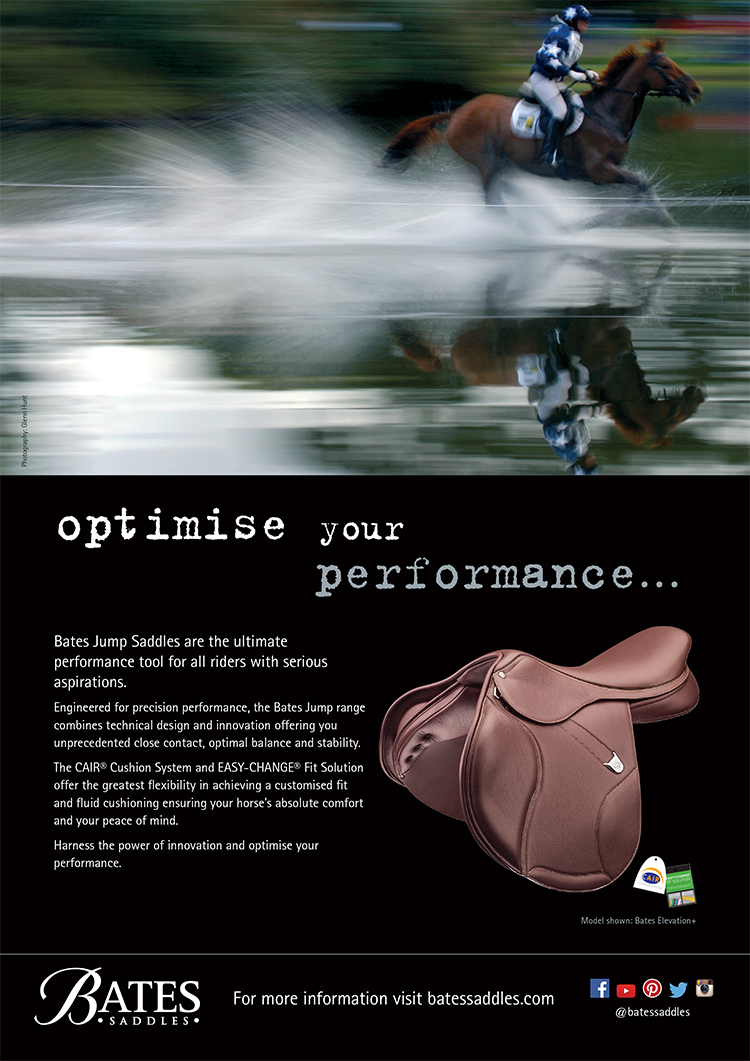

Thanks for the article – I look forward to hearing more from such a knowledgable man.
Please note: it’s Hazel Shannon and Clifford – your captions need adjusting